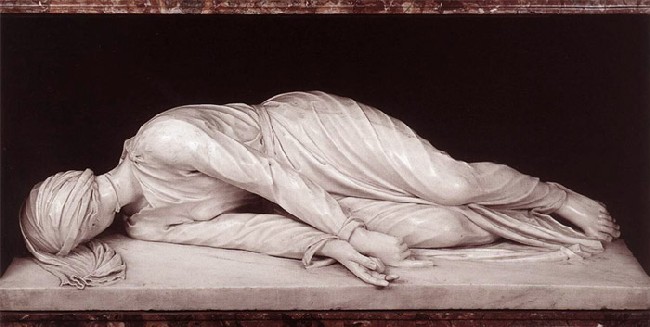
St. Scholastica’s name means “she who has leisure to devote to study.”(reference). She is most well known because God honored her love for her brother, St. Benedict, near the end of her life by bringing a severe storm that kept St. Benedict from leaving her and returning to his monastery.(1)
By tradition St. Scholastica is the twin sister of St. Benedict although Pope St. Gregory the Great’s “The Life of Our Most Holy Father Saint Benedict” does not mention that fact.
St. Scholastica’s brother, St. Benedict, founded twelve monasteries near Subiaco (about 30 miles east of Rome) beginning about 510 AD. Of those original monasteries founded by St. Benedict (before he founded Monte Cassino in about 530 AD), the only monastery that remains today is the one named Santa Scolastica, after St. Benedict’s sister (reference).
Study has been a long resident at Santa Scolastica. Its large and famous library collected over centuries also still exists. Italy’s first printing press was built at Santa Scolastica in 1463 (reference). With the Italy’s first printing press came Italy’s first printed book and the first printed Greek characters anywhere in the world. The style of the Greek font used is still called “Subiaco type” (reference).
When St. Benedict wrote his Rule for how monks should live in monasteries and be guided by an Abbot, he began the Rule with the word “Listen.” Monks, nuns, and sisters following the Rule spend several hours a day in study in their time consecrated to God. Lectio divina (divine reading) is often associated with the monastic life.
All Benedictine monasteries are established as schools for the service of the Lord — surely these most basic elements of St. Benedict’s monastic life — listening and studying in the leisure of God’s time also honor St. Scholastica’s life-long character of silent study of God’s ways and reliance on God’s love.
And could we speculate that the mild nature of the monastic life established by St. Benedict which is often credited with helping St. Benedict’s Rule becoming nearly the universal rule in the West was also influenced by his gentle sister? I like to think so.
___________________________
Footnote
(1) We cannot mention love and St. Scholastica without recalling the following account from St. Gregory’s “Life of St. Benedict.”
“CHAPTER XXXIII
Of the miracle wrought by his sister Scholastica.
“GREGORY
“Who was ever, Peter, in this life more sublime than Saint Paul, who, notwithstanding, three times craved of our Lord to be free from the pricks of the flesh, yet could not obtain it? To this purpose, I must tell you a passage concerning the venerable Father Benedict, that there was something he desired and was not able to accomplish.
“His sister Scholastica, who was consecrated to God from her very childhood, used to come once a year to see him; unto whom the man of god was wont to go to a house not far from the gate, within the possession of the Monastery. Thither she came one day according to her custom, and her venerable brother likewise with his disciples: where, after they had spent the whole day in the praise of God and pious discourses, the night drawing on, they took their reflection together.
“As they were yet sitting at table, and protracting the time with holy conference, the religious woman, his sister, entreated him saying: "I beseech you, leave me not this night, that we may talk until morning of the joys of the heavenly life." To whom he answered: "What is this you say, sister? by no means can I stay out of my Monastery.
“At this time the sky was serene, and not a cloud was to be seen in the air. The holy woman, therefore, hearing her brother's refusal, clasped her hands together upon the table, and bowing her head upon them she prayed to Almighty God. As she raised up her head from the table, there began such vehement lightning and thunder, with such abundance of rain, that neither venerable Benedict nor his Brethren were able to put foor out of doors. For the holy woman when she leaned her head upon her hands, poured forth a flood of tears upon the table by which she changed the fair weather into foul and rainy.
“For, immediately after her prayers, followed the inundation, and the two did so concur that, as she lifted up her head, the crack of thunder was heard, so that in one and the same instant she lifted up her head and brought down the rain.
“Then the man of god perceiving that, by reason of thunder and lightening with continual showers of rain, he could not possibly return to his monastery, was sad and began to complain, saying: "God Almighty forgive you, sister, what is this you have done?" To whom She mad answer: "I prayed you to stay and you would not hear me; I prayed to Almighty God and he heard me! Now, therefore, if you can, go forth to the Monastery and leave me." But he not able to go forth, was forced to stay against his will.
“Thus it fell out that they spent the night in watching, and received full content in spiritual discourse of heavenly matters. By this it appears, as I said before, that he desired something which he could not obtain; for if we consider the mind of the venerable man, he would, without doubt, have had the fair weather to continue in which he set out. But, contrary to what he willed, he found a miracle worked by the courage of a woman in the strength of Almighty God. And no wonder if at that time a woman were more powerful than he, considering she had long desired to see her brother. For according to the saying of Saint John: "God is charity," and with good reason she was more powerful who loved more.
“PETER
“I confess that I am wonderfully pleased with that which you tell me.”




















